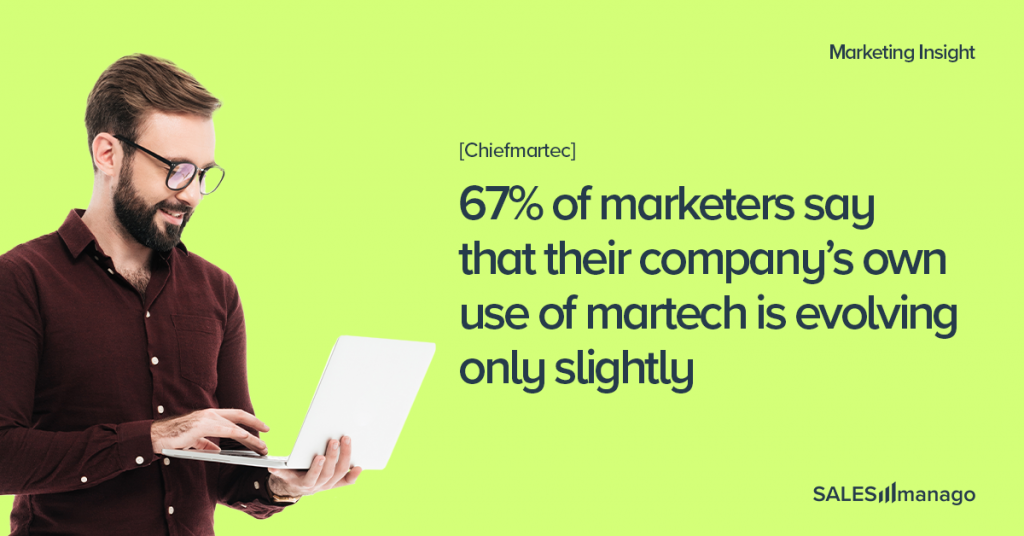
The notion that “marketing is changing” turns out to be oversimplified. The gap between the technologies available and eCommerce companies capability to adapt them is growing exponentially, making the tools, seemingly at your fingertips, a sci-fi superpowers you are not ever going to possess. This, in turn, frustrates the marketers, instilling a sense of insecurity and fear of a looming competition. But there is a way out of this trap. The Lean Way.
A gap is growing and is going to eat you
Funny, how people tend to overlook incoherencies and cognitive dissonances in reality around them. Most of us, as consumers, probably think that online marketing has changed dramatically over the last few years.
We all know that internet technology, martech included, is developing incredibly rapidly. It seems obvious that all this cutting edge tech goes straight to eCommerce companies, revolutionizing ways marketing is being done, right?
In the meantime we tend to ignore third-party data driven popups, displayed mindlessly, almost always ignored and clicked only by accident. Spray-and-pray tactics just became even more insistent. Marketing in eCommerce, generally, did not change so much. So, what about all these new, shiny tech? Where is it?
Research proves that not necessarily in eCommerce companies. The majority of marketers (72%) feel that the marketing technology landscape is changing either “rapidly” or at “light speed”.
At the same time, the majority of marketers (67%) say that their company’s own use of marketing technology is evolving only “slightly” or “steadily” — or “not at all.
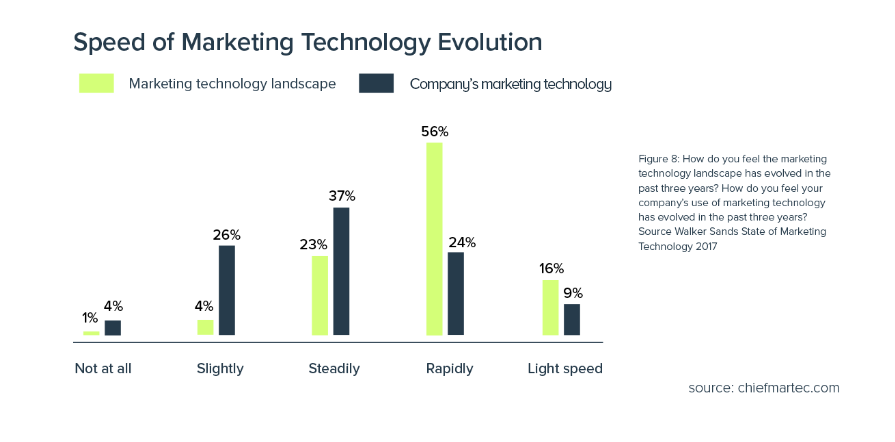
assessment on how Martech stack has changed vs how marketers feel they ogranization adopted it
eCommerce organizations struggle to keep up with Martech. The gap between these two is widening. Is it very bad for marketers? Is it very bad for you? After all, if you can’t keep up with technology, you will surely fall behind the competition. The gap will eat you.
Or maybe not? After all your competitors apparently fare no better than you do. In fact, you can turn this situation to your advantage. In this article we will tell you how.
Martec Law and Inverse Lake Wobegon Effect
Scott Brinker’s Martec Law is actually working
The growing gap between Martec and eCommerce businesses development was described a few years ago by Scott Brinker, as Martec Law.
Technology changes exponentially, but organizations change logarithmically.
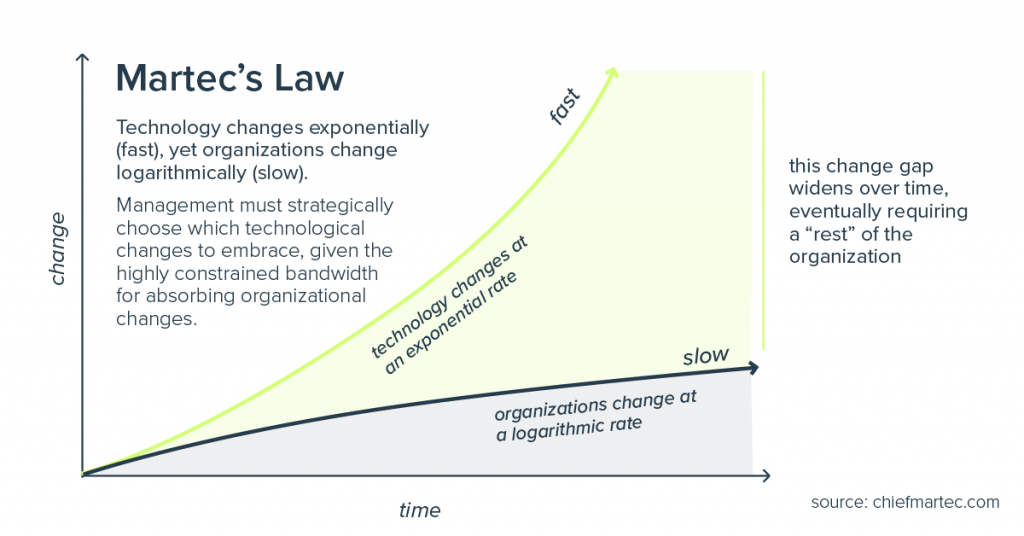
Technology is evolving exponentially, as demonstrated by the graph above. Moore’s Law and Kurzweil’s Law of Accelerating Returns highlight this phenomenon of rapid technological change. However, human organizations struggle to keep up with such swift transformations. Behavioral and cultural shifts take time to establish, and organizations can only absorb a limited number of changes in people, processes, and technology without significant disruptions. Consequently, organizations change at a logarithmic rate, much slower than the exponential pace of technological advancement.
How do we relate to Brinker’s revelations? Well, they perfectly align with our experience with the market. In our recent research we discovered i.eg. that:
- 39% of senior marketers don’t know what a Customer Data Platform is
- 59% think Customer Data Platforms are overlooked by eCommerce marketers
All this in the day and age where extreme level of offer and content personalization is required as obvious by the vast majority of customers – something CDP excels at!
The reasons for this situation are numerous and we actively address at least the most obvious and prevalent of them. For example, some of the essential tools should be, in our opinion, free, to enable the companies to allocate their budgets in more sophisticated and ambitious areas.
Marketers are aware of the gap in their real capabilities and the power they theoretically could wield, if their organizations were able to absorb all the cutting edge tech. How does it influence their self esteem? Here Brikner also has an interesting theory.
Are you a victim of the Inverse Lake Wobegon Effect?
According to him, Martec’s Law also triggers something he calls the Inverse Lake Wobegon Effect in marketing.
To grasp the Inverse Lake Wobegon Effect, we must first understand its counterpart, the Lake Wobegon Effect. The Lake Wobegon Effect suggests that we tend to overestimate our abilities, believing ourselves to be better at things than we truly are. This humorous reference harks back to the fictional town of Lake Wobegon from A Prairie Home Companion, where all the children were touted as being above average.
However, the Inverse Lake Wobegon Effect takes a different stance. It is a phenomenon where we believe ourselves to be worse at something than we actually are, convinced that we fall below the average in our peer group. Consequently, modern marketers find themselves trapped in a perpetual state of feeling behind, despite making remarkable progress by any objective measure. This paradox arises from the ever-widening gap between technological advancements and the pace of organizational adaptation, as depicted in the visual representation below.
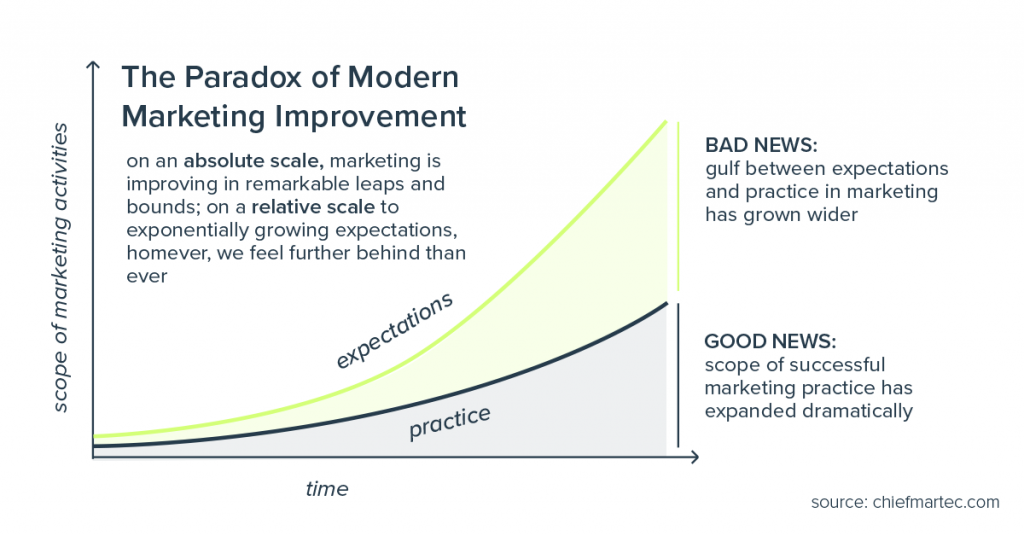
But, much like how not all children in Wobegon can be above average, it is also unrealistic to assume that all marketers can be below average. If you find yourself grappling to keep up with the fast-paced marketing landscape, take solace in the fact that nearly everyone else who is attentive to the industry shares similar sentiments. The feeling of being overwhelmed or lagging behind is a common experience among marketers. Remember, you are not alone in this endeavor.
So cheer up and take some simple steps to escape the Martec Law … the lean way!
Escaping the void
Evolve. Adapt. Overcome
First, do not succumb to the Inverse Lake Wobegon Effect. Nobody even can be up to date with all the technology that appears on daily basis on Martech market. Act smart. Act lean.
Analyze carefully what capabilities you lack the most and absorb only the technology that will enable you to deliver the most value to your customers and company alike. This is one of the Lean Marketing rules.
And it concerns not only the technology but also data – not all datasets are equally valuable. Focus only on these which you can most effectively collect and activate.
Also, try to get as fast and agile with the adoption of the new technologies as possible. Automate all the repetitive actions and focus on creativity. And remember to measure the effects of your actions frequently, after short sprints, to adjust strategies to market reality.
These are all Lean Marketing principles. Sticking to them and making small steps will prepare you for the huge leap, when the time comes.

Reset on your own terms
As Scott Brinker claims, sometimes organization needs deep reset, great change to rapidly close the gap and reposition its development curve closer to the technology curve.
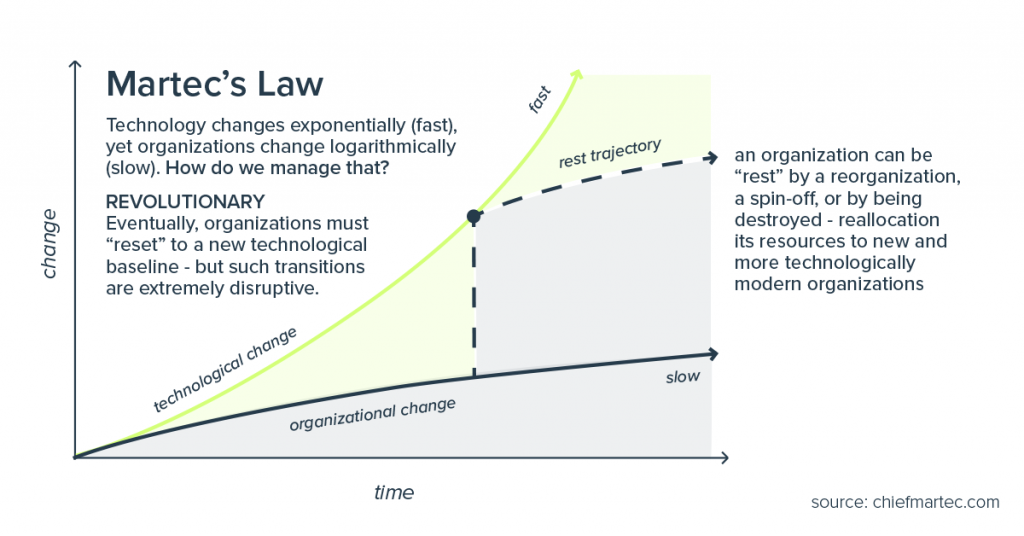
If you first adapted, and adopted the Lean Marketing approach, then the reset is a great chance for you! You are ready to make the leap not in chaos, but on your own terms.
As for today, the most advanced and comprehensive tool, able to become a new foundation of your Martech stack is Customer Data Platform – or even larger system, which CDP is a part of, called Customer Engagement Platform. It will enable you to embrace full Martech support for the Lean Marketing style of managing processes. This process boils down to reaching three core principles:
Customer Intimacy
Implement self-learning solutions that leverage zero- and first-party data. Sticking to this principle enables the marketing team to know their customers better than their best friends. This results in increased loyalty and authentic customer relationships.
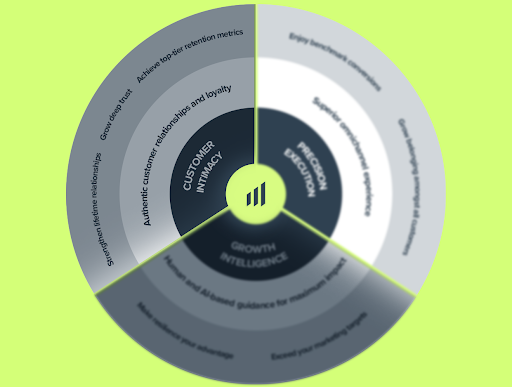
How do you benefit?
- A self-sustainable ecosystem that gathers manages, and uses zero- and first-party data (single profile; no-code approach);
- Capture all customer data automatically across all relevant sources;
- Data enrichment (#1 on G2Crowd) that is dynamically updated with visitor identification and behavior and data tracking (24/7);
- The customer is 100% in control of the gathered data.
Precision Execution
Combine the hyper-personalization of the omnichannel experience with clearly predefined processes. The effects are very straightforward: higher CR, AOV, and CLV and lower customer churn.
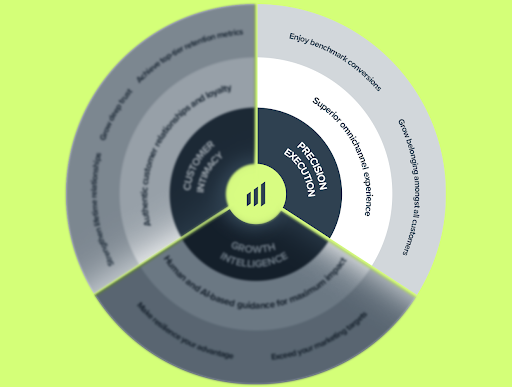
How do you benefit?
- Predictive Modeling (#1 on G2Crowd) using Copernicus Algorithm drives CLV, churn, and Dormancy predictions;
- Dynamic hyper-segmentation;
- Recommendation Engine (#1 on G2Crowd);
- Campaigns executed with 1–1 precision across all relevant channels;
- Transparent multisource revenue attribution trail.
Growth Intelligence
Merge human and AI-based guidance to maximize the impact of your time, eCommerce budget, and strategy without dependency on IT. This enables your company to stay in full control of revenue outcomes.
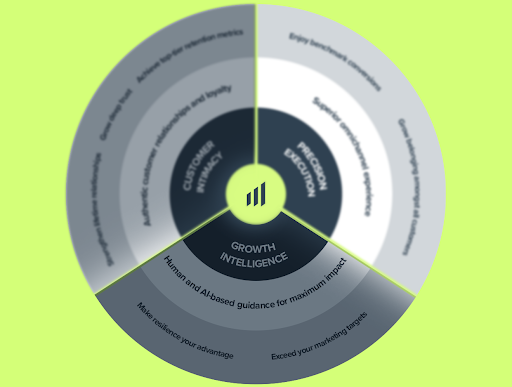
How do you benefit?
- Marketing intelligence informing what works and what doesn’t;
- Step-by-step guidance from the system and from SALESmanago’s personal support for the next best actions toward marketing excellence;
- A no-code design to help non-tech-savvy marketers execute fast and drive business change without relying on IT
It was never easier to escape Martech Law
Martech Law was true even 10 years ago. But the situation was much different back then. Among the multitude of customer data systems, there was no single solution that would actually govern whole data collection, management and activation processes. None of the choices marketers could make were without drawbacks in one area or another.
With the introduction of comprehensive systems like Customer Engagement Platforms, a vast systems, made of modules that can also work on their own, you can now cherry-pick technologies you really need in Lean Marketing processes, before you make a great leap and connect all of them with CDP.
Aware of this, we decided to make the most substantial modules, like AI-driven Email Marketing module, free to all eCommerce marketers, of all companies, regardless of industry and size. We believe that democratization of the access to the rudimentary Martech tools is a part of Marketer Rights.
This is why in 2023 you can evolve, adapt, and overcome without overburdening your organization budget. And when the time comes, the great leap will be but a small step for your company.

 Follow
Follow
















